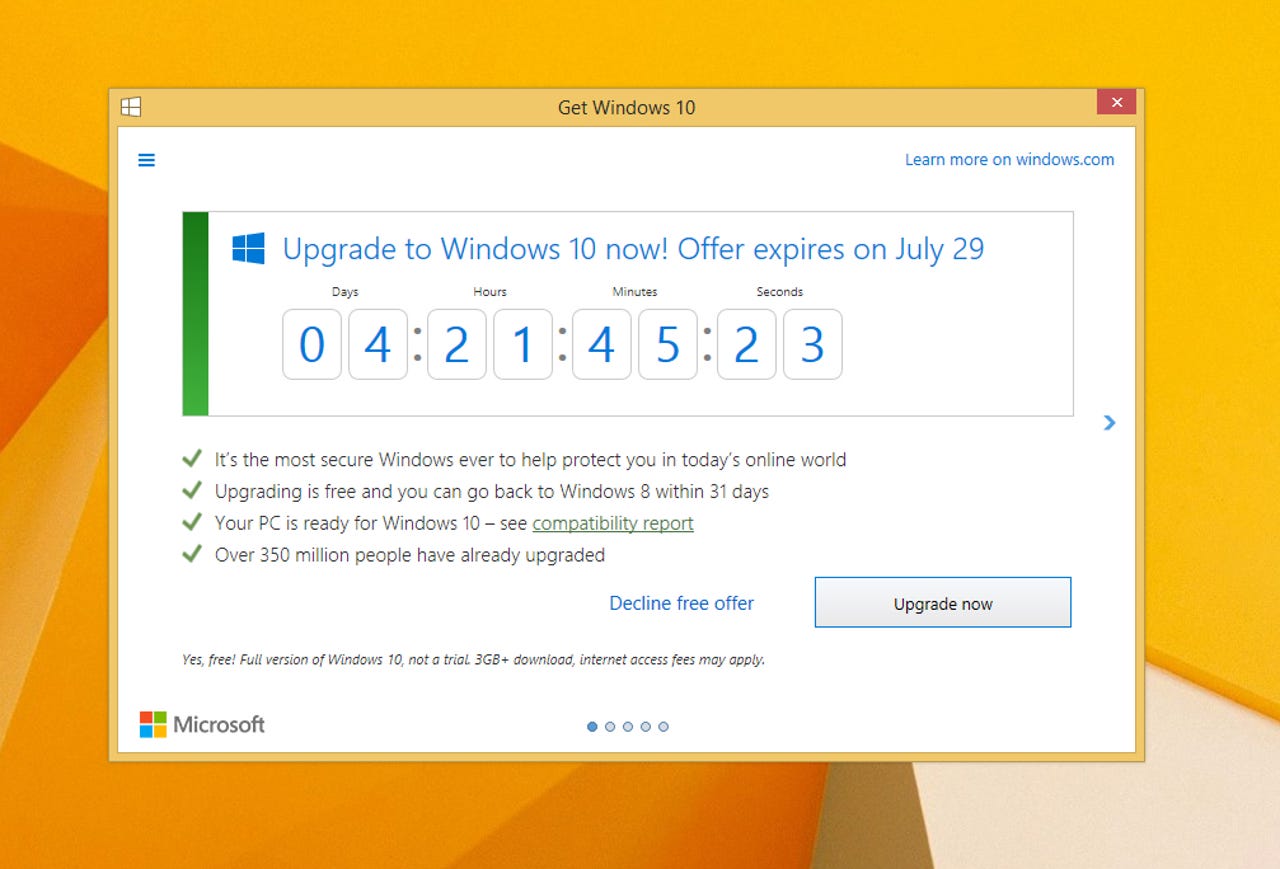Virtually overlooked: Upgrade your Windows 10 VMs while they're still free


Windows 10 free upgrade countdown timer
We are now mere days from the free apocalypse, the end of the Windows 10 upgrade free ride. If you do not upgrade your Windows 7 and Windows 8.1 machines by Friday, you're doomed. You'll never, ever be able to run Windows 10 on your...
Wait. What?
No, it's not that bad. All that's happening is that if you don't finish your upgrades by Friday, you'll have to pay to upgrade to Windows 10. You will still be able to upgrade your machines after Friday. You will still be able to use Windows 10 after Friday.
Windows 10
The world will not be ending on Friday (at least not because of Windows, anyway). We make no guarantee about zombies, alien invasions, or the effect of the Trump and Clinton candidacies on the future of the planet. But your Windows environments will be safe. So there's that.
In fact, your Windows 7, 8, and 8.1 machines will also still get their updates. And if you want to upgrade, you'll just have to buy an upgrade, like we've done with new Windows versions for years now.
So don't freak out. It will all be okay.
That said, why spend on upgrades if you don't have to? Last week, I took you on a tour of ten Windows 10 upgrades I performed over the past weeks. Included in that set were a few virtual machines that I use regularly.
But as I've been talking to people in the last few days, I've heard the same story over and over again. It goes something like this: "We walked around the office and catalogued all our machines. We've checked off those we upgraded, and are catching up on the rest."
When I asked about virtual machines, the folks I talked to looked at me blankly, and then, to a person, responded with a profanity that rhymes with "Oh, spit."
Because they did their machine inventory using the age-old management by walking around technique, those various VMs tucked away on hard drives didn't make it onto the list.
I'm here, therefore, to remind you to upgrade your VMs before the free upgrade ship sails away.
Courtesy of a discussion with ZDNet's Wizard-of-the-Windows, Ed Bott, I have a few additional thoughts and tricks to share.
He suggests that, for some VMs, you might want to claim your upgrade entitlement, but stay on a current version until you're ready to go full steam ahead. In that context, he suggests, "For VMs it is usually ludicrously easy to claim a free upgrade. Set a checkpoint first. Do the upgrade. Confirm you have activated and have a digital entitlement. Roll back to the previous checkpoint. Ta-da."
What I did was simply clone my VMs before upgrading. That way I have a Windows 8.1 version with the same license as the Windows 10 version. While I have no real intention of using the older Windows version, I have a copy around in case I need it. Of course, I'll only use one or the other VM at any given time. That's one of the ways VMs are very helpful.
One note: rather than snapshotting, I cloned the entire VM file. I like this approach better because then there's a pure, completely separate file. You don't have to worry about applying all sorts of delta changes to get back to the originating point.
It also allows me to take the cloned file, stick it on an external hard drive and dump it in my closet. With snapshots, all of that old stuff is attached to the VM as clutter.
For those running Windows VMs on a Mac, Ed has a suggestion for getting fresh installs of Windows 10 working. He says:
- Anyone who has a VM on a Mac by definition has a product key for it. So they don't need to upgrade (although they certainly can if they want to).
- Just create a brand-new VM using the edition of Windows 10 that matches the one they have installed (Pro-to-Pro, Home-to-Home).
- Do not enter a product key during Setup.
- After setup is complete, enter the old product key under Settings > Update & Security > Activation.
Like all the other upgrades I'm taking about here, this approach is valid until Friday.
Ed and I had a bit of a back and forth about why you'd use Windows VMs in production. Generally Windows VMs are used as a testing environment.
We agreed that the scenario where you're likely to be using a Windows VM on an ongoing basis is the one I use: I run Windows on my Mac. For example, when I want to run Microsoft Visio Pro (which doesn't have a Mac version), I launch Parallels and run it in a Windows 10 instance.
After the deadline
For those of you who just need to spin up a Windows 10 VM for a little while to test something or work on a temporary project, you're in luck (and this applies after the July 29 deadline as well). Ed pointed out these interesting notes:
- If it's genuinely for test purposes, you can always download an eval version of the latest Windows edition for free. Enterprise edition is good for 60 days.
- You can download Windows 10 VMs from this link. They are good for 90 days. When the 90 days are up, download new versions.
So there you go. The world isn't coming to an end. While the free ride ends on Friday, Windows 10 will continue to be available in both paid-for upgrades and in free-for-testing temporary installs.
You can follow my day-to-day project updates on social media. Be sure to follow me on Twitter at @DavidGewirtz, on Facebook at Facebook.com/DavidGewirtz, on Instagram at Instagram.com/DavidGewirtz, and on YouTube at YouTube.com/DavidGewirtzTV.